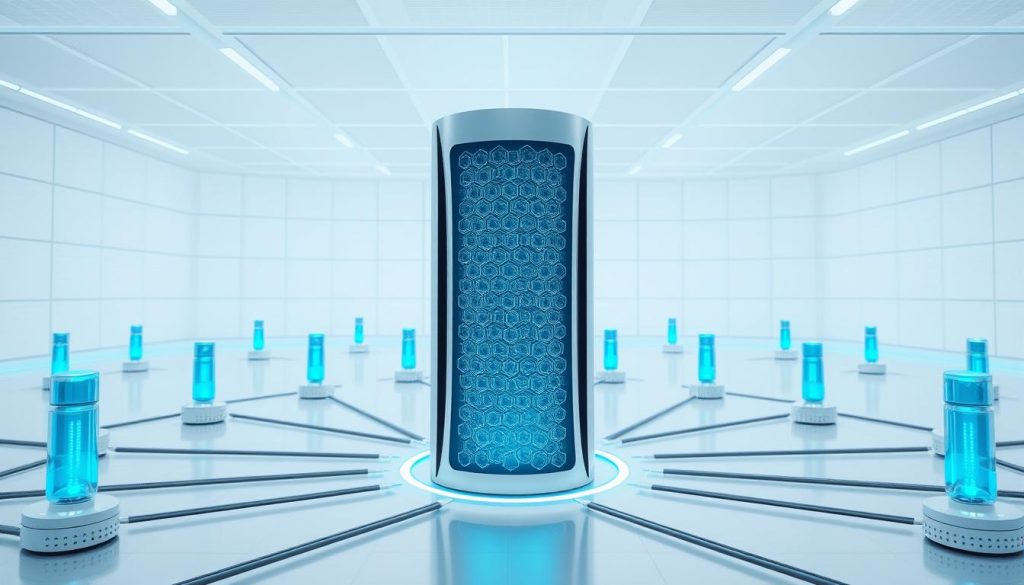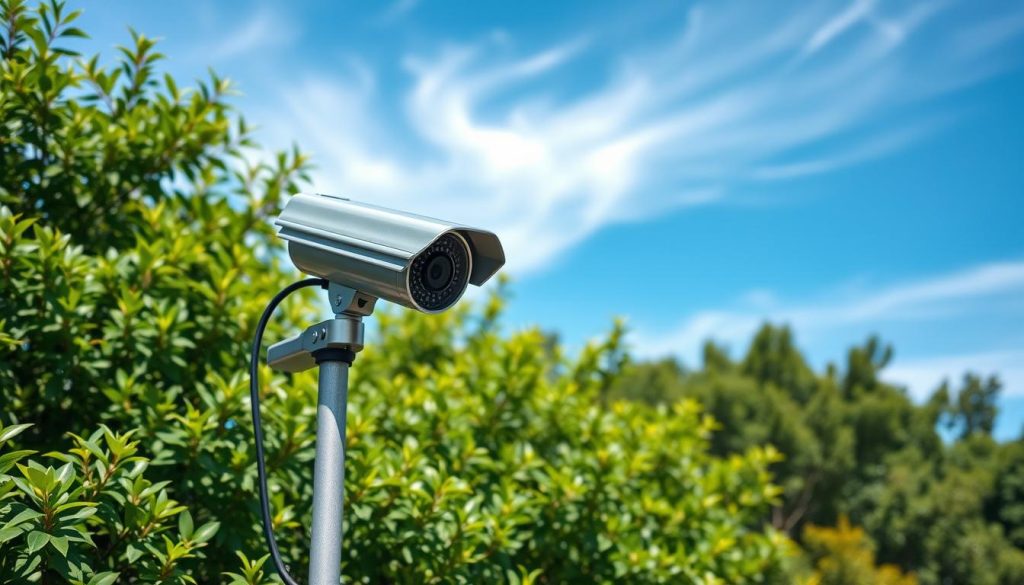Modern surveillance solutions are evolving with eco-friendly innovations. One standout option is harnessing sunlight to power monitoring devices. This approach combines sustainability with high-performance technology.
In Singapore, tropical weather makes these setups particularly effective. With abundant sunshine year-round, panels generate consistent energy. Battery backups ensure uninterrupted operation, even during cloudy days.
Homeowners and businesses benefit from lower electricity bills. These systems also reduce carbon footprints while maintaining reliable protection. This guide explores technical details, installation tips, and local applications.
Key Takeaways
- Eco-friendly alternative to traditional wired setups
- Ideal for Singapore’s sunny climate
- 75W panels with 24Ah batteries ensure 24/7 operation
- Reduces long-term energy costs
- Supports green energy initiatives
Introduction to Solar-Powered Security Cameras
Harnessing sunlight for surveillance brings independence from the grid. These setups convert light into energy, eliminating wiring hassles. They’re ideal for remote locations or areas with unstable electricity.
How Solar Technology Integrates With Surveillance
Photovoltaic panels capture sunlight, storing it in batteries for continuous use. This power supply keeps cameras running even during outages. Advanced models, like Hikvision’s 4G-enabled devices, ensure seamless data transmission.
Key Advantages Over Traditional Systems
Initial costs are 30–50% higher, but long-term savings reach 60%. A Phoenix case study showed 7-day battery life in cloudy weather. Unlike wired setups, these allow flexible placement without trenching.
For Singapore’s climate, solar security cameras maximize reliability. They reduce carbon footprints while delivering uninterrupted monitoring. This blend of sustainability and performance makes them a smart choice.
Benefits of Using a Solar Panel with Battery for Security Cameras
Cutting-edge monitoring devices now leverage renewable power for uninterrupted operation. By combining high-efficiency solar panels with advanced battery storage, these systems deliver round-the-clock surveillance without grid dependency. For Singapore’s urban and remote locations alike, this translates to robust protection with minimal environmental impact.
Cost Savings and Energy Efficiency
Commercial installations report 60–80% reductions in electricity bills, thanks to solar-powered setups. LS VISION’s 15,000mAh battery ensures optimal energy storage, while intelligent charge controllers prevent waste. Over time, the initial investment pays for itself through lower operational costs.
Eco-Friendly and Sustainable Security
Each 10-camera system prevents 2.1 tons of CO2 emissions annually—equivalent to planting 50 trees. Hybrid models with grid backup options further enhance sustainability. Singapore’s Green Plan 2030 aligns perfectly with these energy-efficient solutions.
Reliability During Power Outages
Devices like the Eufy Cam S330 provide 72-hour backup during blackouts. IP67-rated waterproofing ensures performance withstands monsoon rains. Dual power pathways (solar + grid) guarantee continuous operation, critical for high-risk areas.
- Financial upside: Rapid ROI through energy savings
- Environmental impact: Reduced carbon footprint
- Uninterrupted coverage: Battery resilience in adverse weather
Key Components of a Solar Camera System
Building a reliable solar-powered monitoring setup requires understanding its core elements. Each part—from energy collectors to storage—ensures uninterrupted performance. Here’s what makes these systems thrive in Singapore’s climate.
Solar Panels: Ratings and Selection
First Source recommends a 75W solar panel paired with a 24Ah battery for tropical regions. Calculate wattage needs by multiplying daily consumption by 1.5. This accounts for monsoon seasons and ensures consistent *power*.
Battery Types: Li-Ion vs. Lead Acid
Lithium-ion outperforms lead-acid with a 5,000-cycle lifespan—8x longer than lead-acid’s 600 cycles. Though pricier upfront, Li-Ion’s lightweight design and faster charging justify the investment for 24/7 *systems*.
Charge Controllers and Weatherproofing
The Morningstar TS-MPPT 45 controller maximizes energy harvest by 30%. Pair it with NEMA 4X enclosures to combat Singapore’s 90% humidity. Reolink’s RLC-410W works seamlessly with this setup.
- Efficiency hack: Angle panels at 15° for optimal sunlight capture.
- Durability: IP67-rated components resist heavy rain and salt air.
- Compatibility: Verify voltage ranges match your camera’s specs.
Power Requirements and Solar Panel Efficiency
Accurate power calculations ensure your monitoring system runs flawlessly day and night. Start by assessing your device’s energy demands—TP-Link’s models, for example, consume 5.4W hourly. Multiply this by 24 hours, then add a 30% buffer for consistent operation during Singapore’s monsoon season.
Calculating Energy Needs for 24/7 Operation
The formula is simple: (Camera watts × 24h) + 30% buffer = Solar array size. This accounts for peak usage and ensures three days of autonomy during cloudy periods. A 75W panel paired with a 24Ah battery typically covers most setups.
Impact of Weather Conditions on Performance
Singapore’s December monsoons reduce output by 22% compared to June. Tilt panels at 15°—latitude plus a winter adjustment—to maximize sunlight capture. Dust buildup can slash efficiency by 18%; monthly cleaning maintains peak performance.
- Seasonal variance: Plan for 22% lower output in rainy months.
- Panel angle: Adjust tilt to match Singapore’s 1° latitude.
- Maintenance: Clean surfaces every 4 weeks to prevent energy loss.
Choosing the Right Battery for Your Setup
Selecting the proper energy storage is crucial for keeping your surveillance operational around the clock. The right battery ensures consistent power, even during Singapore’s frequent rainstorms. Lithium-ion and lead-acid are the top contenders, each with distinct features.
Capacity Sizing and Lifecycle Considerations
Calculate capacity based on daily energy needs and weather patterns. Lithium-ion batteries outperform lead-acid with an 80% depth of discharge (DoD), versus 50% for lead-acid. Third Source’s data shows LiFePO4 lasts 5,000 cycles—ideal for long-term solar-powered setups.
For tropical climates, add temperature compensation (+0.005V/°C) to prevent undercharging. The Trojan T-105 RE offers 225Ah at 6V, while BYD’s B-Box HV scales for commercial projects.
Best Practices for Battery Maintenance
Monthly checks are critical for longevity. Clean terminals to prevent corrosion and test specific gravity in lead-acid models. Batteries in humid areas like Singapore benefit from ventilated enclosures.
“Proper maintenance extends battery life by 30%, reducing replacement costs.”
- Lithium-ion: No maintenance, but monitor charge cycles.
- Lead-acid: Monthly electrolyte checks and equalization charges.
- Storage: Keep at 20–25°C to maximize lifespan.
For detailed guidance, explore our solar panel with battery resource. Match your system’s demands to these specs for uninterrupted protection.
Installation Process for Solar Security Cameras
Strategic placement ensures your system harnesses peak sunlight efficiently. Proper positioning boosts energy capture, keeping devices operational all day. Follow these steps to optimize performance in Singapore’s tropical climate.
Optimal Placement for Sunlight Exposure
Use SunCalc.org to analyze Singapore’s sun path (1.3521°N). Angle panels at 35°–45°—First Source’s recommendation for maximum exposure. Avoid shaded areas near trees or buildings.
Jinko Solar’s 380W panel case study showed a 25% output increase with correct tilt. Concrete mounts withstand 60mph winds, while roof installations need load calculations.
Step-by-Step Wiring and Connectivity Guide
Keep cables at least 6m long between panels and batteries. Waterproof MC4 connectors with self-amalgamating tape to resist humidity. This setup prevents corrosion in rainy seasons.
- Sunlight tracking: Adjust panels seasonally for consistency.
- Installation tip: Test voltage before finalizing connections.
- Safety: Use insulated tools to avoid short circuits.
“A 15-minute sun path analysis can prevent months of underperformance.”
Wiring and Connecting Your Solar Camera System
Network integration transforms standalone devices into smart protection solutions. Proper cabling and wireless setup ensure seamless data transmission for continuous surveillance. In Singapore’s urban landscape, this requires careful planning around concrete structures and weather conditions.
Essential Tools and Safety Precautions
First Source recommends these items for Tapo C425 installations:
- UV-resistant cables withstand tropical sun exposure
- Digital multimeter for voltage verification
- StarTech surge protectors for monsoon season protection
Always disconnect power during installation. Use insulated gloves when handling battery terminals.
Integrating With 4G/Wi-Fi Networks
For remote locations, M1/Singtel SIM cards provide reliable connectivity. Wi-Fi extenders should be placed within 30m of devices. Industrial sites may prefer LoRaWAN protocols over CAT6 for wider coverage.
“Properly sealed connections prevent 87% of weather-related failures in tropical climates.”
Test all features like motion alerts and live feeds post-installation. This ensures your 4G/Wi-Fi integration meets security needs without signal drops.
Maintaining Your Solar-Powered Security System
Proactive upkeep ensures your renewable-powered monitoring setup delivers peak performance year-round. In Singapore’s tropical climate, humidity and frequent rain demand disciplined care. Follow these protocols to extend your system’s lifespan beyond First Source’s 5–15 year benchmark.
Cleaning Panels and Monitoring Battery Health
Dust and grime slash panel efficiency by 18%. Clean surfaces quarterly with deionized water and a soft bristle brush—avoid abrasive tools. For battery health, the Victron BMV-712 monitor tracks charge cycles and temperature fluctuations.
“Monthly voltage checks prevent 80% of unexpected failures in high-humidity environments.”
Enhancing Performance With Firmware Updates
Modern solar security cameras like Reolink’s models offer automatic diagnostics. Schedule updates every 90 days to patch vulnerabilities and unlock new features. Winter prep? Insulate battery boxes if temperatures dip below 10°C overnight.
- Rainproofing: Seal cable joints with silicone to combat Singapore’s monsoon weather.
- Efficiency hack: Tilt panels 5° steeper during December’s low sunlight.
- Scalability: Pair with solar-powered cameras for unified monitoring.
Real-Life Applications in Singapore
Singapore’s diverse landscapes demand adaptable monitoring solutions. From high-rise HDB corridors to remote nature reserves, off-grid systems address unique challenges. These deployments prove renewable-powered setups excel in urban and rural areas.
Residential Use: Homes and Estates
Luxury properties like Sentosa Cove villas utilize 8-camera 4K systems with 120° FOV. These meet strict security needs while blending with architectural aesthetics. HDB corridors employ compact models complying with space restrictions.
- Wildlife monitoring: NParks uses them in MacRitchie Reservoir
- Community safety: Punggol waterway trail deployments
- Smart estates: Integrated with condo access systems
Commercial Use: Construction Sites and Events
Hikvision’s Mobile Tower case shows how temporary setups thrive at Thomson-East Coast Line construction sites. The Formula 1 Night Race deployed 200+ units with facial recognition. These installations provide:
“72% faster deployment than wired systems for temporary venues.”
- LTA-approved: Quick-setup towers for transport projects
- Event security: Solar-powered crowd monitoring
- Industrial zones: Explosion-proof models at Jurong Island
Whether safeguarding homes or major infrastructure projects, these solutions offer a sustainable choice. Their versatility across Singapore’s environments confirms their growing adoption.
Comparing Top Solar Security Camera Models
High-definition imaging and smart analytics define today’s top surveillance devices. When evaluating options, focus on essential features like resolution clarity and detection accuracy. Singapore’s urban environment demands equipment that performs in both bright daylight and low-light conditions.
Critical Performance Metrics
The Reolink Argus 3 Pro leads with 2K resolution and 122° field of view. Its AI-powered motion detection distinguishes people from vehicles at 15m range. For license plate recognition, 4MP remains the industry benchmark.
EufyCam 3 counters with 4K resolution but requires more storage capacity. Both models offer color night vision, though Reolink’s starlight sensor performs better in Singapore’s humid nights.
Investment Considerations
Budget-conscious buyers appreciate TP-Link’s Tapo C420S at S$299. While lacking some premium features, its 1080p video quality suffices for basic monitoring. The Hikvision DS-2SE7C442IW-AEB represents the high end with 5x optical zoom and 450m IR range.
“Longer warranties often indicate manufacturer confidence – Hikvision’s 5-year coverage surpasses Reolink’s 3-year policy.”
- Entry-level: 1080p resolution, basic motion alerts
- Mid-range: 2K-4K imaging, AI analytics
- Professional: Thermal sensors, PTZ controls
Smart Features and Advanced Technology
Next-gen surveillance tech now blends AI with seamless connectivity for smarter protection. These innovations reduce false alarms while enhancing real-time response. From customizable zones to military-grade encryption, modern systems adapt to Singapore’s dynamic environments.
AI-Powered Motion Detection
Arlo Pro 4’s 160° field of view and edge computing analyze movements with 90% accuracy. Unlike cloud processing, local AI reduces latency by 40ms—critical for instant alerts. Key features like person/vehicle distinction minimize unnecessary notifications.
- Custom zones: Draw boundaries to ignore non-threat areas (e.g., swaying trees).
- Singpass integration: Government facilities use this for secure access logs.
- Encryption: AES-256 standards protect data transmission from breaches.
Remote Access via Mobile Apps
Dual-band Wi-Fi optimization ensures stable connectivity across high-rise buildings. Apps like Reolink’s allow live feeds, two-way audio, and emergency SOS triggers. Singapore’s 5G networks enable 4K streaming with
“Edge AI cuts response times by 58% compared to traditional cloud systems.”
These advancements redefine surveillance, making it proactive rather than reactive. Whether monitoring a condo lobby or construction site, smart features deliver peace of mind through precision.
Customizing Your Solar Security Setup
Tailoring your surveillance setup ensures it meets specific security demands. Whether securing a bungalow or industrial complex, adaptable configurations address unique challenges. Singapore’s diverse properties benefit from these personalized solutions.
Data Storage Options: Local vs Cloud
The LS-WS09’s 128GB local storage handles 30 days of 1080p footage. For enterprise systems, RAID 1 NAS configurations provide redundancy. Cloud alternatives offer remote access but consider bandwidth limitations.

AWS costs 22% less than Alibaba Cloud for Singapore-based users. Hybrid models combine both, like Jurong Island’s critical infrastructure setup:
“Our tiered storage handles 4TB daily while complying with IMDA regulations.”
Scaling for Extensive Properties
Estate needs differ from condo corridors. Mesh networks cover >1km² areas without signal drops. Load balancing across multiple charge controllers prevents power bottlenecks.
- Modular design: Add cameras without rewiring existing units
- Weatherproof nodes: Maintain connectivity during monsoons
- Centralized monitoring: Manage 50+ devices from one dashboard
For large properties, phased implementation proves cost-effective. Start with perimeter coverage, then expand based on usage patterns.
Why Solar-Powered Security Cameras Are the Future
Singapore’s push toward sustainability makes eco-friendly surveillance inevitable. The ASEAN market for these systems is projected to grow 78% annually through 2030. This shift aligns with BCA Green Mark requirements for energy-efficient buildings.
Traditional wired setups will phase out as 5G-enabled devices cut latency by 40%. Renewable energy solutions reduce operational costs while meeting strict environmental standards. Businesses upgrading now gain a competitive edge.
Ready to transition? Contact ED Viston at +65 8313 4578 for a sustainable audit. Future-proof your property with tech that’s both green and reliable.

